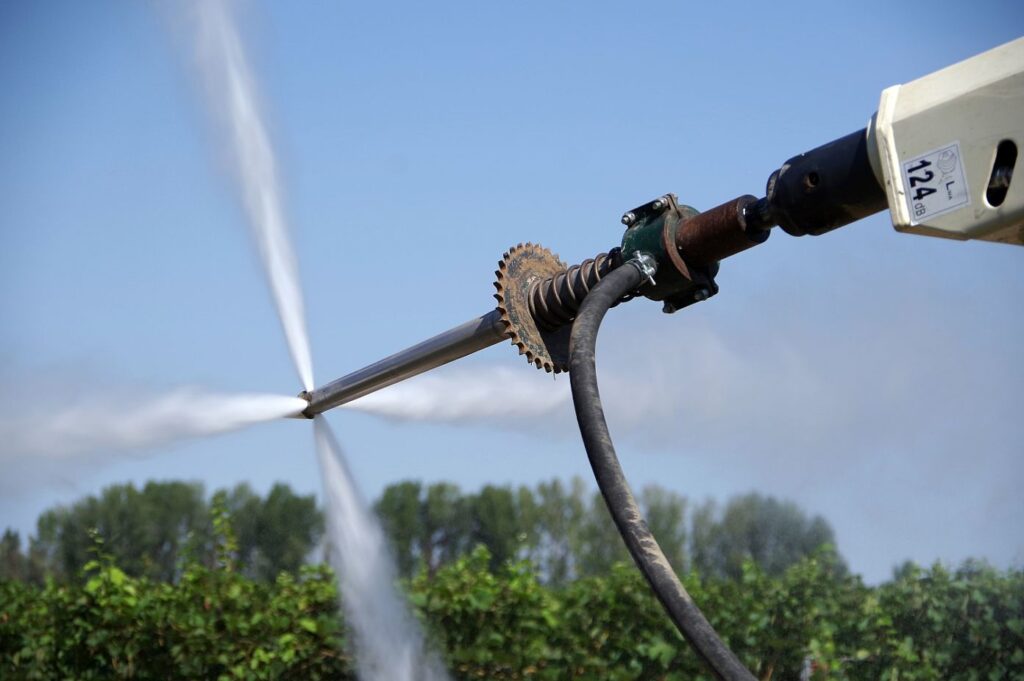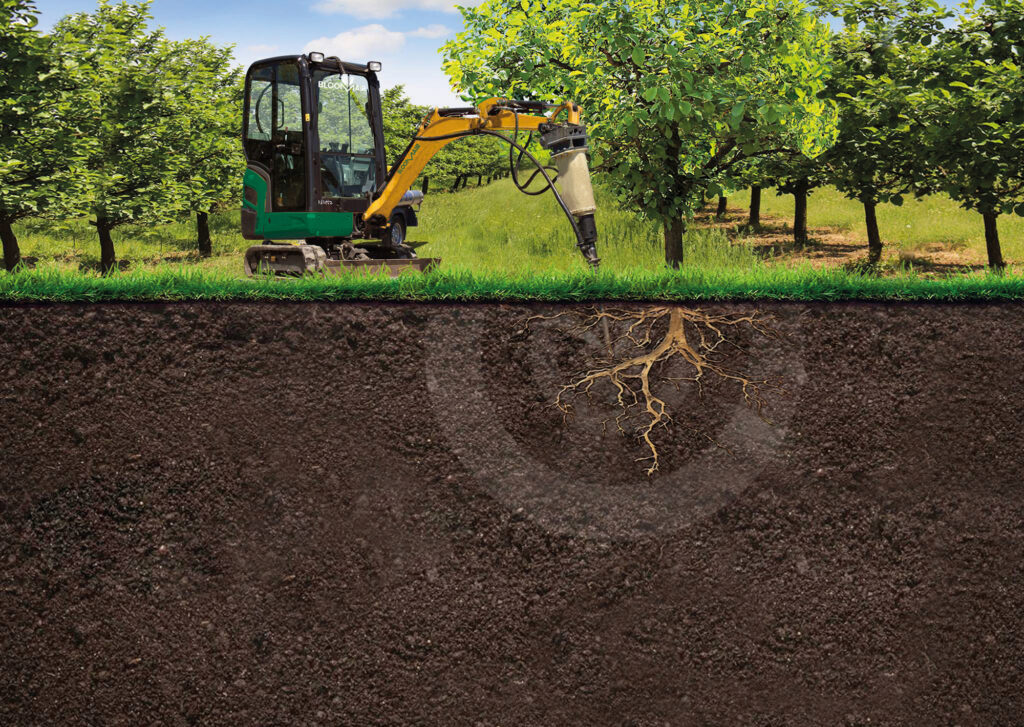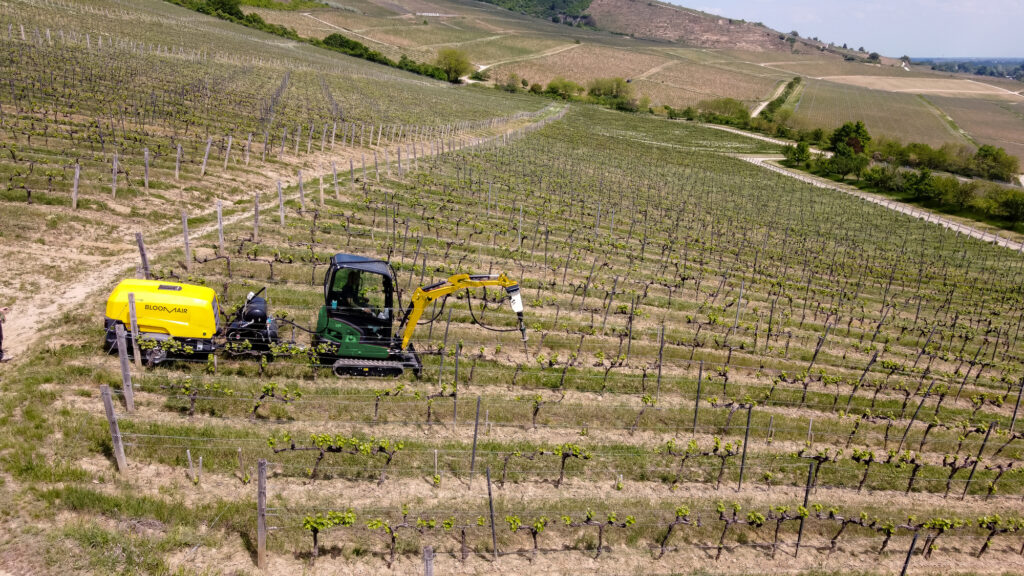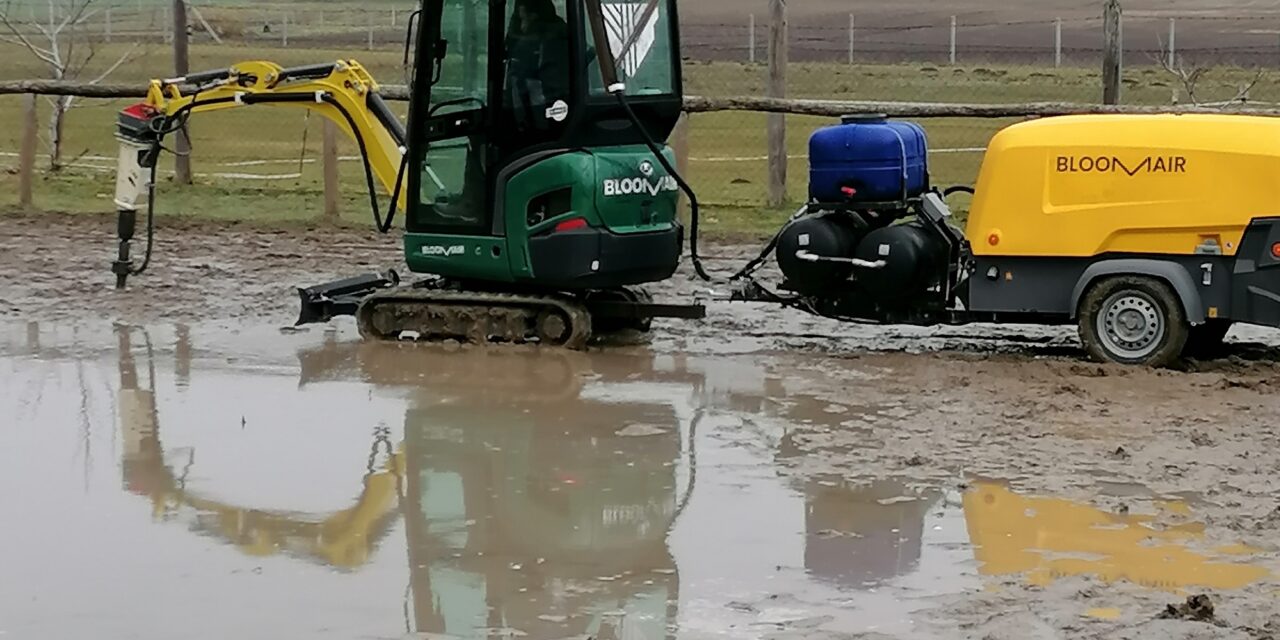A startup company has patented a device that can be used to eliminate internal water in a short time. In addition, the invention is also suitable for providing nutrients to the root system of trees and vines, which can increase the yield.
They founded a startup company three years ago, which is fully Hungarian-owned and the owner of a Hungarian invention with a world patent. Bloomair has developed a precision farming tool, a 'spike', that can be used to do a lot of great and useful things. But what exactly is it about? The basic machine was created for soil loosening, but it soon became clear that the invention is also suitable for many other purposes.
The equipment is not very complicated: it consists of a modified tracked mini-excavator and a compressor connected behind it, the latter providing the high-pressure air for operation. The soul of the system is the spike located at the front of the excavator, which the machine uses a rebuilt demolition hammer to drive into the ground at a depth of 60-80 centimeters. There are holes on the spike that exit in four directions, through which the nutrient is shot to the root system from the container between the excavator and the compressor. (Of course, this last operation is omitted when draining water, because in this case only loosening of the soil is necessary.)

Of course, the machine has limitations, as it requires a machine operator with appropriate expertise, and the length of the shots also depends on whether it is only necessary to loosen the soil or to apply nutrients.
At the moment, one and a half hectares of land can be treated with one machine in one day.
The equipment is also equipped with a telemetry software that continuously measures what kind of nutrients are being applied, with what pressure, how many shots and in what area. In addition, the system also assigns GPS coordinates to the shots, so that the farmer has accurate data about the work done by the end of the day. All of this also provides an opportunity for annual comparisons regarding the yield of certain areas and the development of plant health. The program is constantly being developed.
Internal water is removed in as little as one day
The procedure, which primarily eliminates soil compaction, turned out to be useful in other areas as well.
In addition to optimal soil restoration, the technology can also be used to care for urban vegetation and vegetation.
It is natural for us that we are surrounded by trees even in the big city environment, but this is not their natural environment at all, since they are surrounded by concrete in addition to smog, the risk of infection and other harmful factors, and their root system has a hard time getting nutrients.

Trees living in an unhealthy environment die faster. With the help of technology, trees can be fed in the root zone; the citizens of Szentes could share their opinion about the favorable experiences, as the system has already been successfully applied in the city of the Great Plains. Through soil transformation
it is also possible to plant trees in an area that is currently not suitable for planting or receiving vegetation.
In addition to soil loosening, irrigation, and nutrient intake, the company contacted the municipalities and encountered the problem of restoring the soil condition of areas that were previously flooded with inland water, since one of the causes of inland water is soil compaction. Virga Szabolcs, the company's environmental engineer, shares with us:
for the first time, the system was tested on a horse track flooded with internal water, which worked so well that the next day the water returned to the soil management.
Municipalities also have the opportunity to use the service in an area where internal water often forms due to improper use or evisceration. In these areas, the risk of inundation can be reduced by loosening the compaction of the soil, i.e. restoring it to its original state. Of course, the occurrence of internal water also depends on many other circumstances, but the chance of its occurrence and/or durability can be reduced by repairing the soil structure.
The soil-loosening mini-excavator can also walk in wet areas, so the machine can loosen the soil not only at the edge of the inland water. (By the way, the structure can eliminate soil compaction within a two-meter radius with one blow.) Of course, loosening the soil does not always eliminate the inland water in one day, since the size of the area, the amount of water, and the compaction of the soil are all influencing factors, but it is certain that the damage to farmers or municipalities will be less if they can first start with vital agricultural work, which is otherwise prevented by the inland water. The system can also be used in the case of smaller flash floods, the company believes, although this has not yet been tested in an emergency situation.
Good news spreads like wildfire
During traditional agriculture, the humus layer is disturbed by tillage and plowing, which destroys the soil, its productivity may decrease, and greenhouse gases and other gases, such as carbon dioxide, also enter the atmosphere. "No till", i.e. agriculture without plowing, is given a special role in the policy of the European Union, the goal is to ensure that the member states do not further damage the soil, and that the gases bound in the soil are not released into the atmosphere. Therefore, the support system and the common agricultural policy directive also favor solutions without soil disturbance.
The development of Bloomair is perfect for "no till", as it does not need to disturb the soil layers.
The invention loosens the soil with an air pressure of 12 bar, and can deliver water or a solution mixed with nutrients to the root zone with deciliter accuracy (up to six liters per shot). The technology can be used to treat plantation crops, vineyards and orchards.

Naturally, plants live in vineyards and orchards continuously, the soil becomes depleted after a while, and farmers protect themselves against this with fertilizers. However, the chemicals do not end up in the root zone: some of them are blown away by the wind or washed away by the rain. (During the excessive use of chemical substances, substances may remain on the surface, which can cause salinization.) However, if nutrients are delivered directly to the root zone, these problems can be prevented, and
the gutted soil can be made into a finger with the help of a soil loosening nutrient spray.
The system can also be used against pests, for example, the (natural) repellent is not spread on the surface of the soil, as is traditionally the case, but near the roots, so it is much more effective.
Bloomair has been present on the market for the second year, and the company is also a partner of the Department of Viticulture, Oenology and Plant Research of the Hungarian University of Agriculture and Life Sciences (MATE). In cooperation with the institution, they measure the results of all plant treatments in order to have exact data on effectiveness.
However, the farmers were also convinced by what they saw, the efficiency speaks for itself: several tried the system one by one, and
they found that the yield was better, the plants were healthier, they caught infections less, and therefore they were more resistant to the current extreme climate.
With the experience gained, the service was already ordered in a larger area the following year. Nyakas or Varga Winery did this, for example, as did Hétszőlő in Tokaj, or Laposa in Badacsony or several other estates. The good news – the result of healthier fruit and better average yield – spread like wildfire.

Virga Szabolcs also shares an interesting fact with us: in agriculture, good practices and proven applications are passed down from father to son; older people are - in most cases - less open to new technologies, while their sons are curious, so the Bloomair system was primarily interested in the new generation. And when the elders see that something works, or when the neighboring owner experiences that his competitor is using an innovation with good efficiency, the news spreads quickly. In Badacsony, they reached most of the farmers in this way.
What's more:
more than one grape grower is already negotiating with Bloomair to rent a machine on a long-term basis to take care of their plantation.
If the negotiations lead to success, the company will also start manufacturing the equipment; in addition, it provides education and service to rental farmers.
They are already experimenting with potatoes
The system works very well in plantation culture, but due to the volume in the field, it cannot be used for the time being, even if the farmers suffer greatly from soil depletion, who would be happy if there was a solution on a large-scale scale like Bloomair's. For this reason, the company cooperates with the Potato Research Institute, in the framework of which they investigate the effect of treating and loosening the soil with nutrients on the plant. Although the experiences are favorable, further developments are needed for application in a large area.
Another area where Bloomair technology can be applied is social responsibility.
Due to the emission compensation, the company also undertakes a tree-planting program, which it carries out on the orders of large companies. In this context, for example, they cooperate with airlines: if the latter sell a seat on one of their flights, they compensate by planting a tree.

Bloomair is also constantly looking for partners who want to plant trees in degraded areas, such as closed open-pit mines. Another great example of this: one landfill was declared a recultivation area, but the planted trees did not remain. After Bloomair took care of the area, a park in Borbánya near Nyíregyháza now welcomes those walking along it.
In Balástya, on the Sand Ridge, trees were planted to prevent the spread of sand, the trees have now grown to almost two meters - also thanks to their rapid growth. In the next round, I would bind the quicksand even better by planting acacia, desert elm and Turkestan elm. Everything points in one direction: if they can make poor-quality soil productive, or if they can compensate for its deficiencies, then it becomes possible to plant plants and trees, which is particularly important because, due to the sequestration of carbon dioxide, all of this becomes one of the keys to life on earth in a very short time.
Author: Tamás Császár













